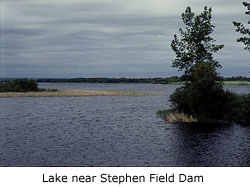IRRIGATION IN MANITOBA

Irrigation has not developed in Manitoba to
the extent that it has in the southern regions
of Alberta and Saskatchewan because the
moisture deficiencies for the production of
agricultural crops are not generally sufficient
to make irrigation a necessity. However, the
greater security and stability of crop production
provided by irrigation would be beneficial to farmers.
In 1982, there were no large-scale irrigation projects in the
province and although there was water available for
irrigation development in some areas, its accessibility
to irrigable areas was very limited. The source of
water for irrigation is largely
from rivers, though some comes from wells where ample groundwater exists.
For the most part, irrigation has been dependent on private funding. However,
because land prices have increased dramatically in
recent years, farmers have begun to invest in irrigation
to increase production while maintaining the same land base.
During the past decade, irrigation development has been
virtually all by sprinkler systems. The hand-move and
solid-set types are most commonly used on small plots
of vegetables and fruits. The centre-pivot systems,
which permit the irrigation of terrain impractical for
irrigation under other methods, have greatly facilitated
the expansion of irrigation of large areas of field crops.
Irrigation Development
During the period 1935 to 1978,
over 400 individual, neighbour and
small community irrigation schemes were
developed throughout the province.
In 1970, a total of 2,970 hectares were
actually irrigated in the province and
the largest area (21 per cent) was for the
irrigation of vegetable crops. By far the
largest amount (approximately 70 per cent)
occurs in the Assiniboine River drainage basin,
followed by approximately equal amounts in each
of the Souris River, Pembina River, Red River
and The Lakes drainage basins.
The Shellmouth Dam, located on the
Assiniboine River near the village
of Shellmouth, was completed by PFRA
in 1970. This reservoir, known as Lake
of the Prairies, has a storage capacity
of 477,400 cubic decametres. The
Rivers Dam on the Minnedosa River,
a tributary of the Assiniboine,
was also constructed by PFRA in
1960 and has a storage capacity of
30,200 cubic decametres. These two
reservoirs will provide a firm water
supply for downstream irrigation
development.

On average, the amount of land irrigated
in the province is 60 hectares per irrigating
farmer. The larger irrigators grow mainly hay
and grains, whereas the smaller ones grow
fruits, vegetables, potatoes and other
special crops. In 1979, government
estimates indicated the total irrigated
area in the province was 5,990 hectares,
with an additional 3,200 hectares developed
for irrigation in 1980.

